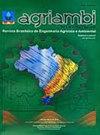在微咸水和不同流速的水培系统中生长的花椰菜植物的水量和消耗
IF 1.4
4区 农林科学
Q3 AGRICULTURAL ENGINEERING
Revista Brasileira de Engenharia Agricola e Ambiental
Pub Date : 2021-06-01
DOI:10.1590/1807-1929/AGRIAMBI.V25N6P422-428
引用次数: 2
摘要
在巴西,有关利用天然微咸水、耗水量和用于花椰菜的营养液流速的研究尚处于起步阶段。本研究的目的是根据巴西半干旱地区营养膜水培系统(NFT)井水的化学特性,评价在微咸水条件下种植花椰菜的产水量和耗水量。采用完全随机设计,4个重复,按6 × 2因子排列,包括6种不同的水配制营养液和2种流速。这些水是基于对巴西伯南布哥州Ibimirim市不同社区水井的微淡水的模拟而配制的,这些井的电导率分别为1.67、3.30、4.71、5.88和13.84 dS - m-1,以及市政公共水。所用营养液的流速分别为1.5和2.5 L min-1。用微咸水配制营养液和补充蒸散损失的营养液降低了菜花的耗水量和产量,且在2.5 L min-1流速下降幅较大。新梢鲜生物量和干生物量产水量以氯化钙水最高。生产花椰菜的最佳水为硫酸钙水,最差水为S2氯化镁水。除S2氯化镁水外,其余水均可用于花椰菜生产;而采用2.5 dS - m-1的流量,作物减产幅度较大。本文章由计算机程序翻译,如有差异,请以英文原文为准。
Water yield and consumption of cauliflower plants grown in a hydroponic system using brackish waters and different flow rates
Studies related to the use of natural brackish waters, water consumption, and flow rates of nutrient solutions applied to cauliflower plants are incipient in Brazil. The objective of this study was to evaluate the water yield and consumption by cauliflower plants grown under the use of brackish waters based on chemical characteristics of waters from wells of the Brazilian semiarid, grown in nutrient film technique (NFT) hydroponic system. A completely randomized design with four replicates was used, in a 6 × 2 factorial arrangement, consisted of six different waters to prepare the nutrient solution and two flow rates. The waters were formulated based on a simulation of brackish waters from wells of different communities of the municipality of Ibimirim, state of Pernambuco, Brazil, which presented electrical conductivities of 1.67, 3.30, 4.71, 5.88, and 13.84 dS m-1, and municipal public water. The flow rates of the nutrient solution used were 1.5 and 2.5 L min-1. The use of brackish waters to prepare the nutrient solutions and refilling the solutions lost by evapotranspiration decreased the water consumption and cauliflower yields, with higher magnitude for the flow rate of 2.5 L min-1. The highest water yield values of the shoot fresh and dry biomasses were found for the calcium chloride water. The best water for the cauliflower production was the calcium sulphate water, and the worse was the S2 magnesium chloride water. The use of all waters is viable for cauliflower production, except the S2 magnesium chloride water; however, the use of the flow rate of 2.5 dS m-1 results in higher decrease in crop yield.
求助全文
通过发布文献求助,成功后即可免费获取论文全文。
去求助
来源期刊

Revista Brasileira de Engenharia Agricola e Ambiental
Agricultural and Biological Sciences-Agronomy and Crop Science
CiteScore
2.70
自引率
16.70%
发文量
114
审稿时长
3-8 weeks
期刊介绍:
A Revista Brasileira de Engenharia Agrícola e Ambiental (Agriambi), periódico oficial da Asociación Latinoamericana y del Caribe de Ingeniería Agrícola (ALIA), é editada mensalmente, no formato eletrônico, pela Unidade Acadêmica de Engenharia Agrícola (UAEA) do Centro de Tecnologia e Recursos Naturais (CTRN) da Universidade Federal de Campina Grande (UFCG), destinando-se à divulgação de artigos científicos originais e inéditos, elaborados em Português, Inglês ou Espanhol. Com o auxílio de pareceres de Consultores, os artigos são aceitos ou não pela Equipe Editorial para publicação na Revista. A Agriambi aceita, também, a submissão de contribuições na modalidade de revisão de literatura.
 求助内容:
求助内容: 应助结果提醒方式:
应助结果提醒方式:


